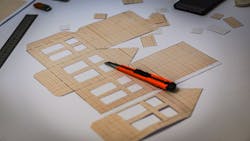Engineering Angles: It’s time for pharma to embrace PPMOF
It’s no secret that the pharma industry is feeling pressure to deliver products at warp speed, leaving companies scrambling to achieve higher productivity without sacrificing quality or breaking the budget.
Implementing prefabrication, preassembly, modularization and off-site fabrication (PPMOF) strategies is one of the most effective ways to realize rapid project delivery. The approach improves quality and safety, maximizes unique skills of diverse project teams, and enables project completion with high cost certainty.
While PPMOF is a tried and true method in many industries, pharma is only starting to embrace it. The time for change is now.
Quality, cost and flexibility
In a recent CRB survey, over 500 industry leaders listed quality, cost and a lack of flexibility among the top three concerns when it comes to adopting PPMOF strategies.
About 93% of the respondents ranked quality as their top PPMOF adoption concern. Off-site construction most often occurs in a factory environment with opportunities for much greater quality control than offered by a traditional construction site. The increased control allows for tighter tolerances on everything from fit and finish of materials to training and oversight of staff.
Furthermore, PPMOF naturally lends itself to collaborative partnerships between designers and tradespeople. This heightened collaboration provides an opportunity for early reviews, quality checks and mitigation of issues.
These early reviews create a ‘safety net’ because they provide valuable guidance regarding quality, efficiency and regulatory concerns. With this knowledge, teams can make adjustments and ensure quality before anything leaves the shop. Hundreds of building and equipment elements can be prefabricated, from piping runs to entire cleanrooms to panelized building skin and modular centralized utility plants. Off-site prefabrication lends itself to Factory Acceptance Testing (FAT), which ensures quality and performance before components arrive at the construction site, in a controlled factory environment.
The survey also found that more than half of respondents from large companies said that cost was a main concern related to PPMOF adoption. The collaborative nature of PPMOF requires organizations to work early in the design process to estimate and negotiate prices. With these decisions made upfront, all parties can move forward with a high level of cost transparency. This approach increases cost certainty by shortening timelines and reducing the need for reconfiguration.
Flexibility was the third adoption concern among respondents. A modular approach is inherently customizable and allows organizations to drive their design decisions throughout the process. Think of it as creating something with Lego blocks. The individual components are standard, but the combinations are endless and flexible, so the team can accomplish goals on time without sacrificing quality or budget. Each individual block is customized to meet your specific needs, current and anticipated. Off-site components can be modified after installation, just as with traditional construction.
Modular designs are inherently standard and repeatable, creating labor and material efficiencies regardless of where construction occurs. Modular designs also create long-term operational efficiencies — streamlining everything from SOPs, training programs, campaign turnover, routine maintenance plans and even facility expansion plans.
Removing roadblocks
Before any work begins, an integrated PPMOF team will establish a project charter. The charter clarifies the business case, defines success, identifies the target value, sets significant deadlines and names important stakeholders. It also outlines subjective conditions like the values the integrated project team relies on to achieve goals.
Creating an effective charter requires open engagement and conversations that develop trust, facilitate communication, and establish a culture of shared ownership.
Quality, cost and flexibility — the same reasons some hesitate to embrace PPMOF fully — are also some of the most significant benefits PPMOF delivers. It’s time to eliminate the ‘we’ve always done it this way’ mentality as a roadblock to innovation and choose PPMOF to achieve success while meeting increased demand
About the Author
James P. Bornholdt
AIA, PE, LEED AP, Director, SlateXpace Technical Operations, CRB
JP Bornholdt, a licensed architect and an engineer with extensive experience in the design and construction industry, has a unique ability to conceptualize and clearly communicate complex solutions to clients. As Director, SlateXpace Technical Operations, JP leads the development and execution of SlateXpace, a CRB solution that breaks from conventional facility design by providing unparalleled flexibility, speed to market and budget control, allowing companies to quickly deliver multiple novel therapies to patients.
